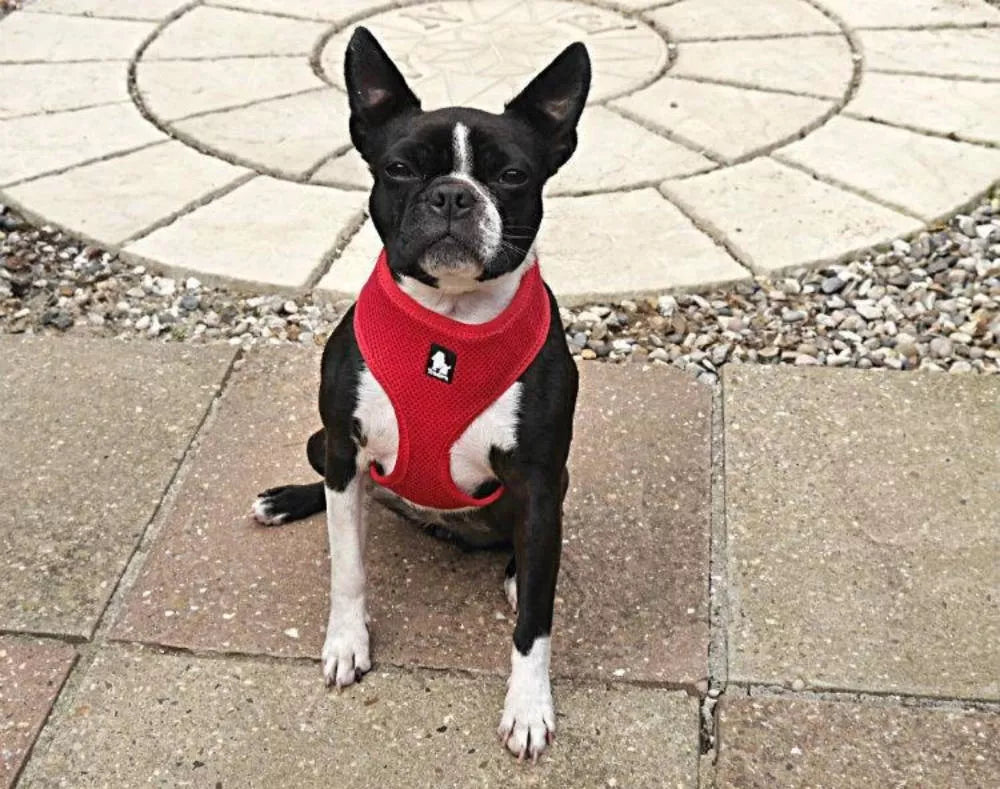Buying A Harness For A Puppy

Choosing the right harness for your puppy should not be a difficult or frustrating process. Before you even begin to look at the vast range of suitable products, have a think about when and how quickly your dog is going to grow. This is a fundamental process and should be the first thing you think about.
If you've conducted some research into your breed, you'll know roughly how big your dog is going to get when it is fully grown. Before you buy a puppy harness, you'll need to map out these areas of growth. This will determine the type and style of harness you buy and will also give you a guide as to how long your puppy is going to be in a harness before it outgrows it! Rest assured, if you do this in the right way, you'll get the right harness for your dog, you'll save money and both you and your dog will be comfortable with your choices.
However, once you have a 10-12 week dog, it is a good time to investigate some of the options when it comes to buying the right harness.
Another option is a harness which has a front and top lead clip. These double up as both every day and no pull harnesses and are great if you want more control. Now, we are convinced that most dogs will not pull on a lead if you train them very early on, but there are a few exceptions.
Some breeds of dog seem to pull more than others and we are only speaking from experience of seeing dogs and their owners at dog shows. We have fitted hundreds of harnesses over the years and we have come across a few pullers. It is not important if this is the fault of the owner or if it just a dog that pulls, but the main objective of the dog owner is always "please get my dog to stop pulling."
More often than not, we manage to fix the problem - or should I say help to reinforce better walking behaviour. Sometimes a harness with 'no pull' attributes will do the job and if owners help this process along by reinforcing and rewarding good walking behaviour then this will normally work. If you have a spaniel or working dog you'll probably benefit from a more padded and substantial harness anyway and the addition of a front clip could be a good thing.
The front clip will give you steering control by using a double ended lead and this type of set up is extremely popular with owners who have dogs that pull.
A lot of dogs don't like things being placed over their heads and as far as we know, this is not an inherent flaw in any dog's personality or behaviour. Unfortunately, it is our own negative behaviour that has caused this issue so it is best not to faff, make it a positive experience and don't wrap your dog in cotton wool - they are much tougher than they look.
Take a look at the range of puppy harness and lead set products here.
If you've conducted some research into your breed, you'll know roughly how big your dog is going to get when it is fully grown. Before you buy a puppy harness, you'll need to map out these areas of growth. This will determine the type and style of harness you buy and will also give you a guide as to how long your puppy is going to be in a harness before it outgrows it! Rest assured, if you do this in the right way, you'll get the right harness for your dog, you'll save money and both you and your dog will be comfortable with your choices.
So how big is your puppy going to get?
Remember that if you get your puppy home at around 8 weeks, it will have to have booster jabs and probably won't go out into the big wide world until around 14-16 weeks. It will be apprehensive and nervous at first so a harness will be the last thing on its mind!However, once you have a 10-12 week dog, it is a good time to investigate some of the options when it comes to buying the right harness.
Which style is best?
This depends on the size and breed of your puppy. If you have a very small dog like a terrier or Chihuahua, you are better to get a simple, light harness that will probably have a fixed size hole for the head and a step through strap at the front. The hole for the head will be fixed and will also get bigger as the size of the harness increases. It is therefore important to get one that will go over your dog's head and have enough room for some growth.The advantages of a step in harness
Another alternative is a step in harness. These are a more robust, padded option and are a great option for both small and larger dogs. They are also a breeze to fit as you simply place the dog's legs in the holes and clip it in at the sides - they literally take 5-7 seconds to fit and take off. The lead attaches to a couple of clips that come together at the top and are usually secure and strong enough for larger breeds too.Another option is a harness which has a front and top lead clip. These double up as both every day and no pull harnesses and are great if you want more control. Now, we are convinced that most dogs will not pull on a lead if you train them very early on, but there are a few exceptions.
Some breeds of dog seem to pull more than others and we are only speaking from experience of seeing dogs and their owners at dog shows. We have fitted hundreds of harnesses over the years and we have come across a few pullers. It is not important if this is the fault of the owner or if it just a dog that pulls, but the main objective of the dog owner is always "please get my dog to stop pulling."
More often than not, we manage to fix the problem - or should I say help to reinforce better walking behaviour. Sometimes a harness with 'no pull' attributes will do the job and if owners help this process along by reinforcing and rewarding good walking behaviour then this will normally work. If you have a spaniel or working dog you'll probably benefit from a more padded and substantial harness anyway and the addition of a front clip could be a good thing.
The front clip will give you steering control by using a double ended lead and this type of set up is extremely popular with owners who have dogs that pull.
Will I have to buy more than one harness?
Our advice is to get the harness you like the look of and one that is a good fit for the size, breed and characteristics of your dog. You should allow growing room in every harness but it is better to check the size guides to see how much room you'll have. If your dog grows quickly and to a size that outgrows its current harness, then it is a good idea to get the next size up in the harness you like. As we said before, in some cases you could try a lighter fixed head harness to start and then move onto a more substantial one later.Do I need to measure my dog?
In most cases, yes. It is always better to measure your dog so you can buy the right size to start things off. If you measure your dog around the neck and chest girth, this will give you a good idea of where you need to start. If these sizes are very close to the next size up then get the next size up - many harnesses can be tweaked to go even smaller than their stated minimum size and this will just mean that there is a bit more strap at each end of the buckle - and it won't be too long before your are increasing the size!Get your puppy use to a harness as soon as possible
If you do get the right starter harness it is a good idea to introduce the puppy to it as soon as possible. Put the harness on and take it off regularly and don't make a big deal about it - the sooner the dog thinks that the harness is a part of life the better. You don't have to walk the dog with the harness at all, but it should be a positive experience.A lot of dogs don't like things being placed over their heads and as far as we know, this is not an inherent flaw in any dog's personality or behaviour. Unfortunately, it is our own negative behaviour that has caused this issue so it is best not to faff, make it a positive experience and don't wrap your dog in cotton wool - they are much tougher than they look.
Take a look at the range of puppy harness and lead set products here.
-
Posted in
buying a puppy dog harness, getting the right puppy dog harness, puppy dog harness, which puppy dog harness is best





